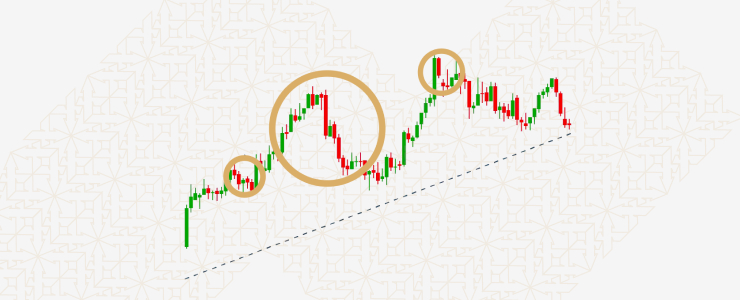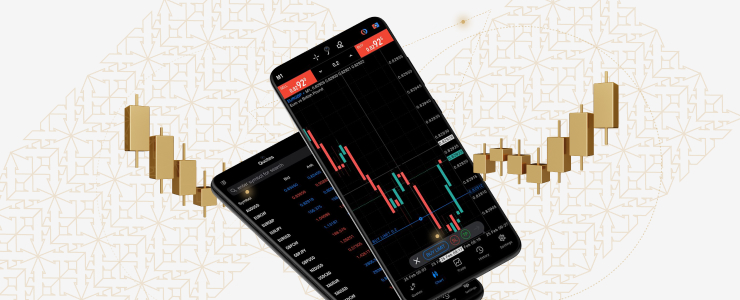There are many trading strategies to suit different personalities, goals, and risk tolerance levels.In this article, we’ll go over the top 7 forex trading strategies so you can choose the strategy that works best for you.
Position Trading
Position trading is a long-term trading strategy that mostly depends on fundamental analysis. It involves holding a forex position for several months, and the aim is to capitalise on major forex market movements and trends.
Support and resistance trading as well as trend trading are popular forex strategies used in position trading. In trend trading, traders use technical tools such as moving averages to identify and follow the prevailing market direction. Support and resistance trading focuses on identifying important price levels, known as support and resistance zones – where price movements are likely to reverse or stop.
Another popular approach is breakout trading, which helps traders understand if there are signals of a new trend. Breakouts happen when price moves above or below support or resistance levels.
Pullback trading is also used in position trading. This is a temporary price reversal within a larger trend.
Swing Trading
Swing trading is a medium-term trading strategy. Forex traders aim to capitalise from price swings in both directions.
Swing traders hold positions for a few days to a few weeks, expecting the market to move in their favour over time, unlike day traders who make multiple trades in a single day.
As traders look for patterns and signals in price charts, timing is important in swing trading as is technical analysis. Therefore, traders often use both technical and fundamental analysis to identify the best entry and exit points.
Swing trading is a good choice if you don’t have time to keep an eye on the charts during the day but can spend a few hours analysing the market every night.

Day Trading
Day traders make multiple trades within a single day. The objective is to capitalise on short-term price changes within the same trading day. In order to avoid the risk of overnight price changes, day traders buy and sell assets within the same trading day and make sure to close their positions by the end of the day.
Day traders heavily rely on technical analysis. Most day traders use technical indicators that help in determining market conditions and making informed trading decisions. The popular ones are RSI, MACD, and the Stochastic Oscillator.
Day trading is best for traders with a good grasp of the financial markets. Since it is a fast-paced strategy, it involves high risk; so if you are a beginner or do not have enough time to monitor the market, then this type of trading probably isn’t meant for you.
Day trading is suitable for traders who want flexibility in their trading. Throughout the day, day traders may open 1 to 5 positions during the day and close them all when goals are reached or stopped out.
Like other short-term trading styles, day traders need to be disciplined. Traders should use a pre-determined strategy, complete with entry and exit levels, to manage their risk.
Price Action Trading
Price action trading is trading price movements on a chart, without relying heavily on indicators.
There are two main types of price action strategies:
- Reversal patterns, which signal changes in the direction of a trend.
- Continuation patterns, which show movements that continue after a pause.
Traders use price action to recognise patterns like flags, triangles, and head and shoulders for both trend continuation and reversal setups.Candlestick patterns are also important as they identify shifts in market sentiment and potential entries or exits.
Price action strategies are flexible and can be used in all markets. This makes them a great choice for both beginners and experienced traders who want to understand real market movement.

Algorithmic Trading
Algorithmic trading or algo trading uses computer programming that follows a set of instructions to place a trade. It is an automated trading process that uses data such as price, time and trading volume, or any mathematical model.
Algorithmic trading attempts to remove emotions from trades, ensures the most efficient execution of a trade, places orders instantly, and may lower trading fees.
News Trading
News trading is a strategy where traders speculate on price movements brought on by economic, political, or environmental events. Some examples of these events include central bank announcements, inflation data, employment rates, geopolitical tensions, wars, or natural disasters.
The first step for news traders is to find scheduled macroeconomic or corporate events, such as economic data releases or earnings reports. After that, they analyse the possible impact of these events and develop a strategy around the event. News traders also aim to capitalise on market volatility due to breaking news.
Trend Trading
Trend traders hope to capitalise on market opportunities by identifying and following the direction of the prevailing trend. Trading is considered a medium-term strategy that works well for traders who often hold their positions for extended periods of time in order to capitalise on significant price movements.
Traders use technical analysis to detect trends and only enter positions in the direction of the pre-determined trend.
A reliable system for recognising and tracking trends is important for success in trend trading. However, since trends can reverse suddenly, traders must stay alert and flexible. Market reversals are a main risk, but tools like trailing stop-loss orders can help manage this risk effectively.
Several trend-following tools can be used to analyse different forex markets, including currencies, stocks, and commodities. ‘Riding the trend’ can be challenging, so trend traders need to be patient. Disciplined trend traders, who are confident in their trading system, can follow their strategy. But it’s equally important to recognise when a system has stopped working. This often happens when there is a fundamental shift in the market, therefore it’s important to cut losses early and let profits run.
One of the main advantages of trend trading is that it allows traders to capitalise on existing market trends, instead of attempting to predict future direction. Traders can avoid the risks related to counter-trend positions by following the trend. Strong trends often offer multiple opportunities to enter and exit trades.
Compared to other trading styles, trend trades may have greater overnight risks because they are often open over several days.

Choosing the right trading style
With the right market conditions, any trading style can be effective. The key is to choose a trading strategy that aligns with your personality, discipline level, available capital, time commitment, and risk tolerance.
You can use more than one trading style. It’s crucial to keep in mind that the most successful traders are adaptable and can alter their strategy in response to opportunities. Learning about different trading styles is a smart idea. You can better adapt to changing market conditions by understanding and combining different strategies.
It takes time and patience to become a successful trader, and part of the process of developing your trading skills includes making mistakes and losses.
Disclaimer:This information is not considered investment advice or an investment recommendation, but instead a marketing communication.




